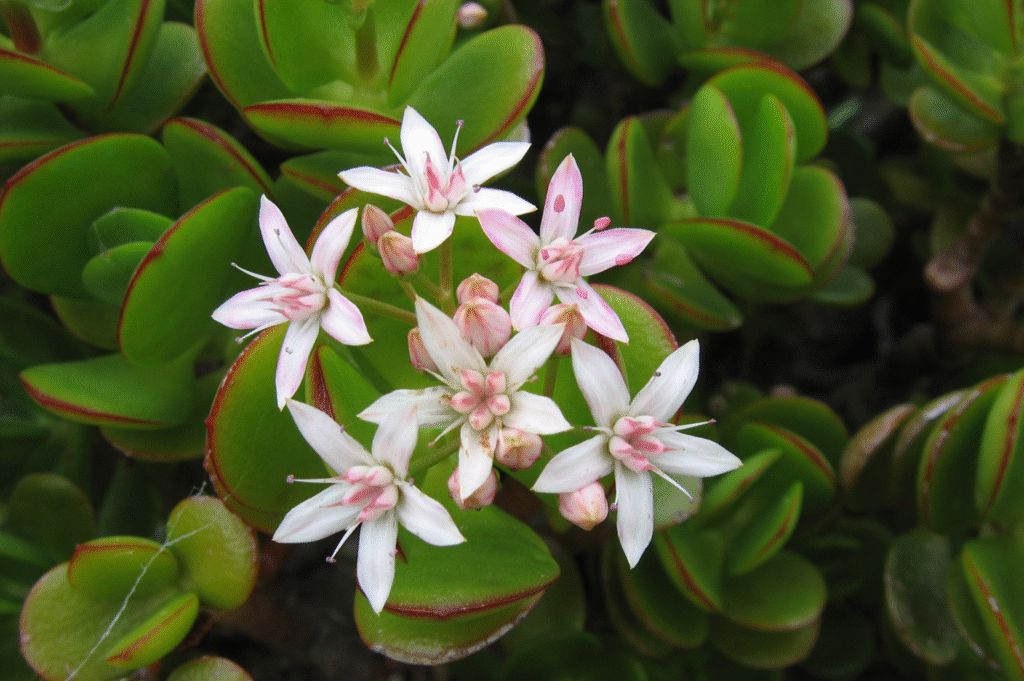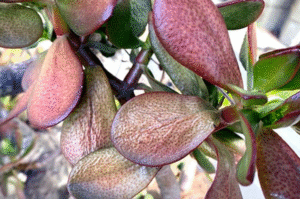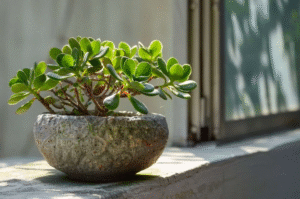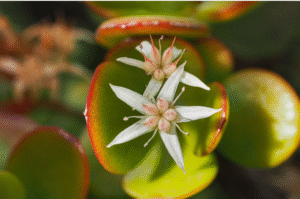Jade plants (Crassula ovata) are among the most loved succulent houseplants due to their glossy leaves, tree-like appearance, and low-maintenance care. But one question many plant owners ask is Does a jade plant bloom? The short answer is yes, it can bloom, but only under specific conditions. This article breaks down everything you need to know about jade plant flowers, including how to encourage blooming, why yours may not be flowering, and what to do when it finally does.
Do Jade Plants Bloom?
Yes, jade plants can bloom, but not all of them do, especially when grown indoors. These charming succulents produce delicate star-shaped flowers, typically white or light pink, that grow in small clusters. However, blooming is rare in home environments, and most people never see their jade plant flower unless they replicate near-perfect natural conditions.
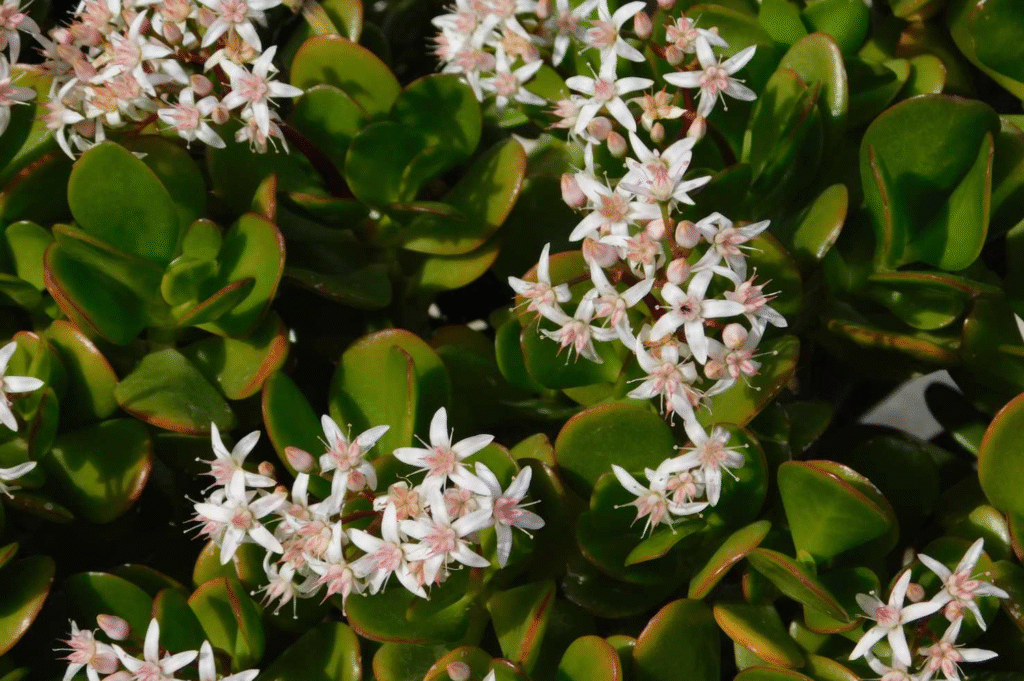
When Do Jade Plants Bloom?
Jade plants usually bloom during late winter or early spring. The flowering period is often triggered by environmental factors like:
- Cooler night temperatures (50–55°F or 10–13°C)
- Shorter daylight hours
- Dry soil with less frequent watering
So if you’ve never seen your jade bloom, don’t worry — it’s not unhealthy; it’s just not receiving the right signals to flower.
What Do Jade Plant Flowers Look Like?
Jade flowers are tiny and star-shaped, forming in small, round clusters at the tips of mature branches. They are typically white with a hint of pink and have a mild, pleasant fragrance. Although subtle, the flowers create a beautiful contrast against the thick green leaves.
What Age Does a Jade Plant Need to Be to Bloom?
Jade plants need to be at least 3 to 5 years old, though most bloom when they are older, 8 to 10 years is more common. A mature jade that’s slightly root-bound and has experienced stress (in a healthy way) is more likely to flower than a younger, freshly repotted one.
What Triggers a Jade Plant to Flower?
To get your jade plant to bloom, you need to mimic the plant’s natural environment. Here’s what encourages flowering:
1. Cooler Night Temperatures
In nature, jade plants bloom after experiencing cool winter nights. Try placing your plant in a spot where the night temperature drops between 50–55°F (10–13°C) for a few weeks.
2. Short Daylight Hours
Jade plants respond to shorter days and longer nights. Keep your plant in natural lighting conditions, limiting exposure to artificial light after sunset.
3. Dryer Conditions
Cut back on watering in the fall and winter. Let the soil dry out completely between waterings. Too much water can prevent blooming.
4. Root-Bound Pot
A slightly root-bound plant is more likely to flower. Avoid repotting your jade too often. Stress (in a healthy, controlled amount) encourages blooms.
5. Bright, Indirect Light
While jade plants enjoy sunlight, direct hot rays can burn the leaves. Aim for bright, indirect light, especially during cooler months.
Tips to Encourage Your Jade Plant to Bloom
Here’s a simple checklist for getting your jade to flower:
| Condition | Recommendation |
| Age | At least 5–8 years old |
| Light | Bright, indirect sunlight |
| Watering | Infrequent in winter (every 3–4 weeks) |
| Temperature | 50–55°F at night for several weeks |
| Fertilizer | Use low-nitrogen fertilizer in fall |
| Stress | Keep slightly root-bound |
Why Isn’t My Jade Plant Blooming?
Many indoor jade plants never bloom because of the comfort; they grow in optimal warmth and lighting all year round. Here are common reasons why your jade might not flower:
- It’s too young
- Receiving too much water
- Getting too much artificial light at night
- Temperatures never drop enough
- Repotted too recently
Should You Prune Jade Flowers?
Yes, once the blooms fade, it’s a good idea to prune the spent flowers. This helps the plant redirect energy into leaf and root growth. Use clean, sharp scissors to remove the flower stalks, and your jade will continue thriving.
Does Flowering Harm the Plant?
No, flowering does not harm the jade plant. It’s a sign that the plant is mature and healthy. However, too many blooms can be a sign of stress, especially if followed by leaf drop or stunted growth. Make sure to balance care and avoid forcing blooms year after year.
Can Fertilizer Help Jade Plants Bloom?
Absolutely, but timing is everything. Use a low-nitrogen, phosphorus-rich fertilizer (like 10-20-10) in early fall. Do not over-fertilize, as too much nitrogen will promote leafy growth instead of flowers.
Best Varieties of Jade That Bloom
While most jade varieties can bloom, these are more likely to do so under the right conditions:
- Crassula ovata (Classic Jade)
- Crassula ovata ‘Hummel’s Sunset’
- Crassula arborescens (Silver Dollar Plant)
These types have a stronger tendency to flower, especially when grown outdoors in zones 10–12 or indoors with proper light and care.
Final Thoughts: Is It Worth Chasing Jade Plant Flowers?
If you’re growing a jade plant mainly for its aesthetic leaves and easy care, then flowering is just a bonus. While blooms are rare, they are possible and beautiful when they do occur. If you want to see your jade plant bloom, simulate a mini winter season indoors (reduce water, lower the temperature, and give it proper light).
Frequently Asked Questions (FAQs):
Can jade plants bloom indoors?
Yes, but it’s rare. Indoor jade plants need cooler temperatures, less light exposure at night, and dry conditions to flower.
How long do jade flowers last?
Jade plant flowers usually last a few weeks before fading and drying up.
Should I remove flowers after they die?
Yes. Deadheading (removing faded flowers) helps keep the plant healthy.

